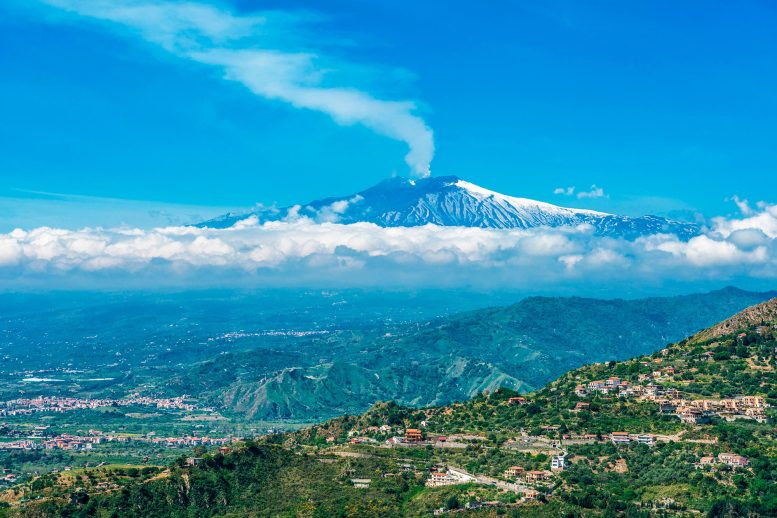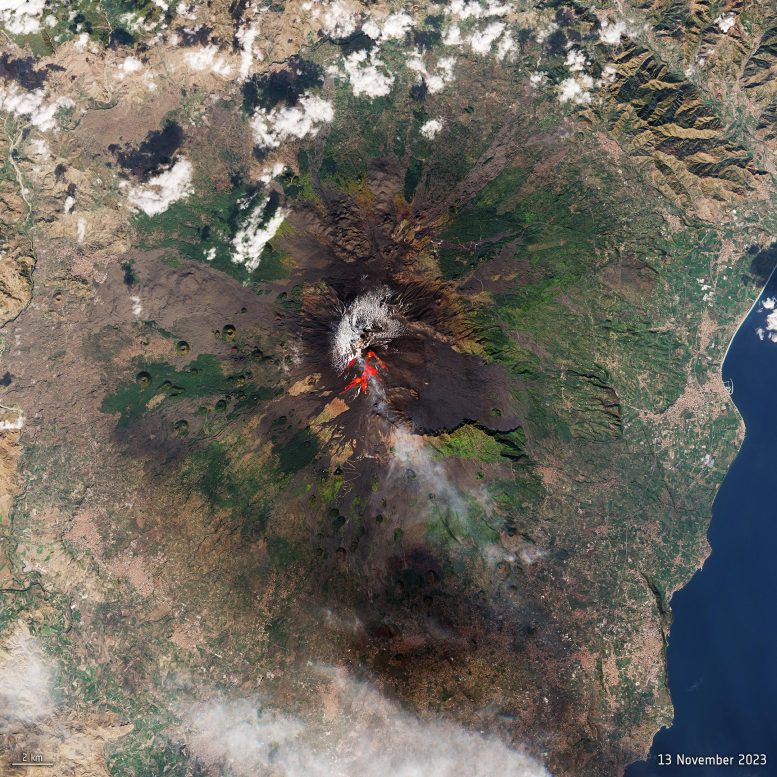One of the world’s most active volcanoes, Mount Etna, erupted on Sunday – spewing lava and clouds of ash high over the Mediterranean island of Sicily. This image, captured on November 13 by the Copernicus Sentinel-2 mission, has been processed using the mission’s shortwave-infrared bands to show the lava flow at the time of acquisition.
Standing at an elevation of approximately 11,014 ft (3,357 m), Mount Etna is in an almost constant state of activity. Ash and clouds created because of frequent eruptions pose a threat to the nearby city of Catania, situated on Sicily’s coast.
Footage of the most recent event was shared on social media, showing huge plumes of molten rock and lava shot into the night sky. Despite the volcano’s activity and ash precipitation, Catania Airport has remained open.
Mount Etna isn’t the sole volcano under surveillance in Europe. Iceland is also bracing itself for an impending volcanic eruption. Earthquake swarms have been recorded in the town of Grindavik as a magma tunnel forms beneath the region – prompting the evacuation of thousands of people.
Satellite data can be used to detect the slight signs of change that may foretell an eruption. Once an eruption begins, optical and radar instruments can capture the various phenomena associated with it, including lava flows, mudslides, ground fissures, and earthquakes. Atmospheric sensors on satellites can also identify the gases and aerosols released by the eruption, as well as quantify their wider environmental impact.

Mount Etna, Europe’s tallest and most active volcano, dominates the landscape of eastern Sicily, Italy. Rising to about 3,329 meters (10,922 feet), its height varies with ongoing eruptions, which have been recorded since 1500 B.C.
Mount Etna, located on the east coast of Sicily in Italy, is one of the most renowned and active volcanoes in the world. Towering with a prominence of about 3,329 meters (10,922 feet), though this height varies with each eruption, it is the tallest volcano in Europe and one of the most prominent landmarks of the Italian landscape.
Etna’s geological history spans over 500,000 years, with its first recorded eruptions dating back to 1500 B.C. This stratovolcano is characterized by frequent eruptions, which are often accompanied by lava flows, ash clouds, and occasionally pyroclastic flows. Its activity has shaped much of the island’s topography and greatly influenced the surrounding Mediterranean ecosystem.
The volcano’s fertile volcanic soils support extensive agriculture, with vineyards and orchards spread across its lower slopes. Etna’s diverse environments, including its summit craters, lava flows, and a variety of vegetation, make it a hub of biodiversity.
Recognized for its scientific and cultural significance, Mount Etna was declared a UNESCO World Heritage Site in 2013. It continues to be a subject of extensive scientific study and a popular destination for tourists and researchers drawn by its majestic eruptions and unique natural environment. Despite its frequent activity, the settlements around Etna, including the city of Catania, have adapted to living in close proximity to this dynamic and powerful natural phenomenon.










Be the first to comment on "Mount Etna’s Fiery Fury: Lava and Ash Eruption Towers Over Sicily"